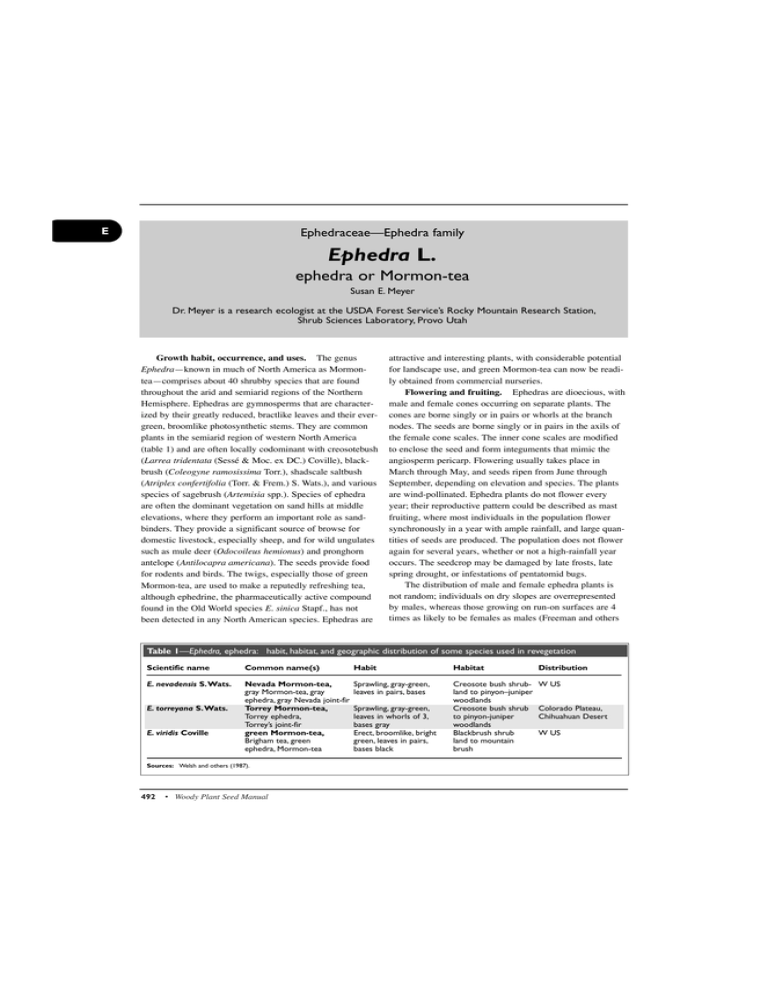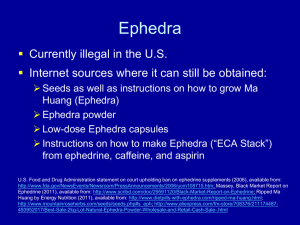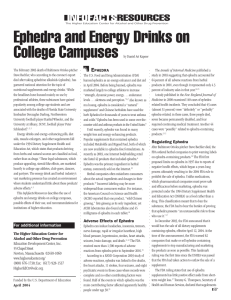Ephedra ephedra or Mormon-tea Ephedraceae—Ephedra family E
advertisement

E Ephedraceae—Ephedra family Ephedra L. ephedra or Mormon-tea Susan E. Meyer Dr. Meyer is a research ecologist at the USDA Forest Service’s Rocky Mountain Research Station, Shrub Sciences Laboratory, Provo Utah Growth habit, occurrence, and uses. The genus Ephedra—known in much of North America as Mormontea—comprises about 40 shrubby species that are found throughout the arid and semiarid regions of the Northern Hemisphere. Ephedras are gymnosperms that are characterized by their greatly reduced, bractlike leaves and their evergreen, broomlike photosynthetic stems. They are common plants in the semiarid region of western North America (table 1) and are often locally codominant with creosotebush (Larrea tridentata (Sessé & Moc. ex DC.) Coville), blackbrush (Coleogyne ramosissima Torr.), shadscale saltbush (Atriplex confertifolia (Torr. & Frem.) S. Wats.), and various species of sagebrush (Artemisia spp.). Species of ephedra are often the dominant vegetation on sand hills at middle elevations, where they perform an important role as sandbinders. They provide a significant source of browse for domestic livestock, especially sheep, and for wild ungulates such as mule deer (Odocoileus hemionus) and pronghorn antelope (Antilocapra americana). The seeds provide food for rodents and birds. The twigs, especially those of green Mormon-tea, are used to make a reputedly refreshing tea, although ephedrine, the pharmaceutically active compound found in the Old World species E. sinica Stapf., has not been detected in any North American species. Ephedras are attractive and interesting plants, with considerable potential for landscape use, and green Mormon-tea can now be readily obtained from commercial nurseries. Flowering and fruiting. Ephedras are dioecious, with male and female cones occurring on separate plants. The cones are borne singly or in pairs or whorls at the branch nodes. The seeds are borne singly or in pairs in the axils of the female cone scales. The inner cone scales are modified to enclose the seed and form integuments that mimic the angiosperm pericarp. Flowering usually takes place in March through May, and seeds ripen from June through September, depending on elevation and species. The plants are wind-pollinated. Ephedra plants do not flower every year; their reproductive pattern could be described as mast fruiting, where most individuals in the population flower synchronously in a year with ample rainfall, and large quantities of seeds are produced. The population does not flower again for several years, whether or not a high-rainfall year occurs. The seedcrop may be damaged by late frosts, late spring drought, or infestations of pentatomid bugs. The distribution of male and female ephedra plants is not random; individuals on dry slopes are overrepresented by males, whereas those growing on run-on surfaces are 4 times as likely to be females as males (Freeman and others Table 1—Ephedra, ephedra: habit, habitat, and geographic distribution of some species used in revegetation Scientific name Common name(s) Habit Habitat Distribution E. nevadensis S.Wats. Nevada Mormon-tea, gray Mormon-tea, gray ephedra, gray Nevada joint-fir Torrey Mormon-tea, Torrey ephedra, Torrey’s joint-fir green Mormon-tea, Brigham tea, green ephedra, Mormon-tea Sprawling, gray-green, leaves in pairs, bases Creosote bush shrubland to pinyon–juniper woodlands Creosote bush shrub to pinyon-juniper woodlands Blackbrush shrub land to mountain brush W US E. torreyana S.Wats. E. viridis Coville Sources: Welsh and others (1987). 492 • Woody Plant Seed Manual Sprawling, gray-green, leaves in whorls of 3, bases gray Erect, broomlike, bright green, leaves in pairs, bases black Colorado Plateau, Chihuahuan Desert W US 1976). The genetic basis for sex differentiation in Ephedra is not known, but the spatial arrangement of males and females functions to maximize reproductive output, as it places males where their pollen can be easily wind-dispersed early in the season and females where they are more likely to have resources later in the season to ripen a seedcrop. North American ephedra species fall into 2 groups characterized by differences in seed size and dispersal ecology (table 2). The large-seeded species (for example, green and Nevada Mormon-teas) are dispersed by scatter-hoarding rodents such as kangaroo rats (Dipodomys spp.), which deposit them in shallowly buried caches and later return to eat most of the seeds or sprouts. The cone scales in these species are small. In small-seeded species (for example, Torrey Mormon-tea) the outer cone scales are large and membranous, and the intact cones are often seen windrowed at some distance from adult plants. The seeds are apparently wind-dispersed, as they have long, awnlike points that probably make them unattractive to rodents. Cones with seeds intact may remain on the surface for many months. Fruit collection, cleaning, and storage. Ephedra seeds (figures 1–3) are easily collected when fully ripe by beating the branches over a hopper or pan; in mast years, large quantities can be collected in a short time. The collection window is narrow and crops must be watched carefully, as ripe seeds can be dislodged by wind or rain in a single day. Seed fill is usually high (table 2), but it is a good idea to check fill in the field before harvesting, as late drought can prevent filling of seeds that otherwise look normal. After the seeds are thoroughly dried, they may be broken free of the cone scales in a barley de-bearder if necessary and then cleaned in an air-screen cleaner (fanning mill). The seeds are usually long-lived in warehouse storage if initially of high quality, and storage times of 15 years may result in little viability loss (Stevens and others 1981). In a warehouse storage experiment, seedlots stored from 10 to 20 years had an average viability of 80% (n = 3), whereas seedlots stored from 20 to 30 years had an average viability of 31% (n = 12). The vigor of the older lots was low, however, as evi- Figure 1—Ephedra nevadensis, Nevada Mormon-tea: seed. denced by their low germination in response to chilling (<5% for lots >20 years old). It is doubtful whether seedlots >20 years old could be field-seeded successfully. The ability to remain highly viable for many years (orthodox storage behavior) facilitates stockpiling of ephedra seeds collected in mast years for use over the period when few seeds are produced. Seed germination and testing. Ephedra seeds are sometimes dormant at harvest, but this dormancy usually disappears through after-ripening after a few months in storage (Kay and other 1977). The dormancy also disappears after short periods (2 to 4 weeks) of chilling; this chilling also hastens the subsequent germination of nondormant seeds (Kay and others 1977; Meyer and others 1988). In experiments with 6-month-old seedlots, 7-day germination for unchilled seeds at 10 to 20 °C was 10% for 1 lot of green Mormon-tea, 49 to 54% for 2 lots of Nevada Mormon-tea, and 95 to 100% for 3 lots of Torrey Mormontea. The 7-day germination after 2 weeks of chilling at 1 °C was over 90% for all seedlots. Germination is generally highest at temperatures of 15 to 20 °C, except in more dormant lots, which show higher percentages of germinatation in temperature regimes that include a temperature in the chilling range (Young and others 1977). Germination is suppressed by higher temperatures, which probably prevent the Table 2—Ephedra, ephedra: seed weight and viability data Seed weight Range Species E. nevadensis E. torreyana E. viridis /g 33–57 108–128 28–62 Mean /oz 935–1,615 3,060–3,630 790–1,760 /g 43 118 47 /oz % viability Range Mean 1,220 3,345 1,330 84–94 76–91 46–100 89 83 89 Sources: Belcher (1985), Kay and others (1977), Meyer (1995), Meyer and others (1995), Monsen (1995). Ephedra • 493 E E Figure 2—Ephedra viridis,Torrey Mormon-tea: (outer) and cone (center) with single seed. seeds Figure 3—Ephedra nevadensis, Nevada Mormon-tea: itudinal section through a seed. long- more dormant lots (AOSA 1993; Meyer and others 1988). Ungerminated seeds should be scored for viability using tetrazolium staining, which is also an acceptable substitute for a germination test. Seeds should be allowed to imbibe water, then clipped or slit on the cotyledon end and immersed in 1% tetrazolium solution for 8 hours. Seeds are then bisected longitudinally for evaluation. Nursery and field practice. Large-seeded species of ephedra have been successfully established from direct seeding using drilling or with a seed dribbler or thimble seeder. If seeds are distributed aerially, a method for covering them with soil must be provided, as the seeds must be planted for successful establishment. Seedlings emerge and establish quickly and can withstand considerable drought once established. Emergence is best from depths of 1 to 2 cm (4/10 to 8/10 in) (Kay and others 1977). Emergence in green Mormon-tea is epigeal and the seedlings resemble those of conifers, whereas emergence in Nevada Mormon-tea is reported to be hypogeal (Kay and others 1977). Late-fallseedings have been successful in the northern part of the range, where most effective precipitation comes in winter; whereas early-summer-seedings are recommended in the southern part of the range, where rainfall comes in the summer. Ephedra planting stock may be produced either in bareroot or container culture. Plants do best in a coarse welldrained medium. Roots are fragile, so stock must be handled very carefully to avoid damage. The root systems of container stock are often too small to bind the root plug together, and those of bareroot stock are also usually poorly developed, resulting in low root–shoot ratios. Outplanting success rates are generally quite low (<50%). References otherwise nondormant seeds from precocious summer germination. Ephedra seeds germinate readily during prolonged chilling. Kay and others (1977) reported 76% germination during a 30-day stratification at 2 °C for a Mojave desert collection of Nevada Mormon-tea. In chilling experiments with the 6 seedlots mentioned above, weeks to 50% germination at 1 °C varied from 6 to 7 weeks for the Torrey Mormon-tea collections and from 8 to 9 weeks for collections of the other 2 species. All viable seeds germinated during chilling within 12 weeks. Official rules for testing green Mormon-tea call for a 4week test at 15 °C, with the option of a 4-week prechill for 494 • Woody Plant Seed Manual AOSA [Association of Official Seed Analysts]. 1993. Rules for testing seeds. Journal of Seed Technology 16(3): 11–13. Belcher E, ed. 1985. Handbook on seeds of browse shrubs and forbs.Tech. Pub. R8-TP8. Atlanta: USDA Forest Service, Southern Region. 246 p. Freeman DC, Klikoff LG, Harper KT. 1976. Differential resource utilization by the sexes of dioecious plants. Science 193: 597–599. Kay BL, Ross CM, Graves WL, Brown CR. 1977. Gray ephedra and green ephedra. Mojave Reveg. Notes 19. Davis: University of California, Department of Agronomy and Range Science. 8 p. Meyer SE. 1995. Unpublished data. Provo, UT: USDA Forest Service, Rocky Mountain Research Station. Meyer SE, Kitchen SG, Wilson GR, Stevens R. 1988. Proposed rule: Ephedra viridis green mormon tea. Association of Official Seed Analysts Newsletter 62(1): 18–19. Monsen SB. 1995. Unpublished data. Provo, UT: USDA Forest Service, Rocky Mountain Research Station. Stevens R, Jorgensen KR, Davis JN. 1981. Viability of seed from thirty-two shrub and forb species through fifteen years of warehouse storage. Great Basin Naturalist 41: 274–277. Welsh SL, Atwood ND, Higgins LC, Goodrich S. 1987. A Utah flora. Great Basin Naturalist Memoirs: 1–894. Young JA, Evans RA, Kay BL. 1977. Ephedra seed germination. Agronomy Journal 61: 209–211.








